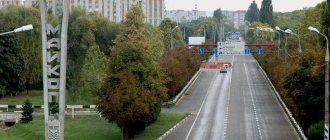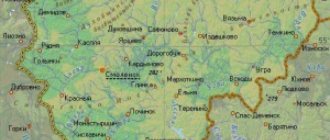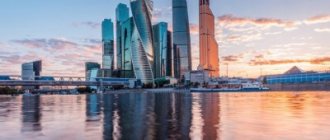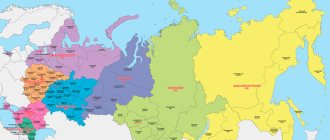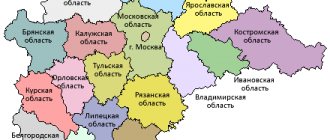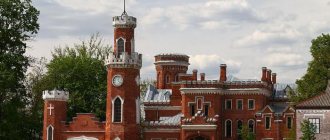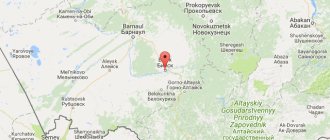Administrative centers of Russian regions
It was necessary to find data on the administrative centers of Russian regions in Excel format. I searched on the Internet - in text format as much as I wanted, but I couldn’t find the excel tables “Administrative centers of the regions of Russia”. I had to do it myself. At the same time I added the population according to census data. In 2022, the excel table was supplemented with data on the population of Russia for 2018 - 2022. Data from the Rosstat report - Demographic Yearbook of Russia 2019
I thought it might be useful to someone - use it.
Regions included in central Russia, regional centers, large cities on the map
The map of Central Russia includes the areas:
- Vladimirskaya;
- Ivanovskaya;
- Kaluga;
- Kostroma;
- Moscow;
- Ryazan;
- Smolenskaya;
- Tverskaya;
- Tula;
- Yaroslavskaya.
Map of Central Russia
The administrative centers of the regions are the major cities of the geographical area.
Vladimir region
The Vladimir region, lying between the Oka and Volga rivers, accounts for the eastern part of Central Russia. Vladimir is a regional center and a large city with a population of 358,000 people located on the banks of the Klyazma River.
The city has a rich historical past - it was the center of the Vladimir Principality. The largest cities in the region are Kovrov and Murom. 138,000 people live in Kovrov, 110,000 people in Murom.
Ivanovo region
The Ivanovo region is the smallest among the regions of Central Russia in area - 21,436 km². There are 1,004,192 people living in the region. The regional center is Ivanovo, located 273 km east of Moscow. The city of Ivanovo is the center of the textile industry.
The regional center has a population of 406,112 people. The second most populous city of Kineshma is located on the right bank of the Volga River. It is home to 83,869 people. Kineshma is dominated by private buildings; the city's architecture resembles a large village. Shuya, the former weaving capital, has a population of 58,721 people. Shuya is located 32 km from the city of Ivanovo.
Kaluga region
The Kaluga region neighbors the Moscow region in the northeast. Area – 29767 km²,
population - 1,009,375 people. Kaluga was built as a fortress city in 1371 on the banks of the Oka River. The ancient Russian city was part of the Moscow Principality. The city's population is 341,000 people. Obninsk ranks 2nd in population in the region and has 115,030 people. Located in the north of the Kaluga region, 69 km from Kaluga on the banks of the Protva River.
Kostroma region
On the map of Central Russia, the Kostroma region is the easternmost. The area of the region is 60,210 km², with a population of 637,230 people. Kostroma is a regional center with a population of 271,444 people, geographically located in the west of the region. The city is located at the confluence of the Kostroma River and the Volga and is included in the Golden Ring of Russia tourist route.
Large cities in the region are Sharya, Bui, Nerekhta. The population of the cities ranges from 24,000 to 36,000 people. They are located on the waterways: Sharya in the east of the region on the Vetluga River, the city of Bui is located north of the regional center on the Kostroma River, the city of Nerekhta is located south of the city of Kostroma on the Nerekhta River.
Moscow region
The map of Central Russia shows the location of the Moscow region in the central part of the region. The region is closely adjacent in the center to a subject of the Russian Federation, a city of federal significance, Moscow. In fact, Moscow serves as the main city of the region, but is not part of the Moscow region. The territory of the Moscow region, or Moscow region, is home to 7,503,384 people.
The major cities of the Moscow region are:
- Balashikha;
- Khimki;
- Podolsk;
- Korolev;
- Mytishchi;
- Lyubertsy;
- Elektrostal.
The population of large cities ranges from 150,000 to 220,000 people. In large cities of the Moscow region, the population is growing due to the close proximity to Moscow and well-established transport links with the capital. The process of gradual merging of the cities of Khimki and Lyubertsy with Moscow is underway.
Ryazan Oblast
The Ryazan region has 8 neighboring regions. The border with the Moscow region is in the north-west. Ryazan is a regional center with a population of 527,904 people. The city has a 2000-year history.
Modern Ryazan is a center of the oil refining industry and mechanical engineering. The largest cities of the Ryazan region are Kasimov with a population of 30,690 people, Skopin - 26,328 people. Kasimov is located northeast of Ryazan on the banks of the Oka River. Skopin is located south of Ryazan. Skopin is famous for its pottery making.
Smolensk region
The map of Central Russia represents the areas located around the center of Russia - the city of Moscow. The Smolensk region is located in the west of the region, on the Smolensk-Moscow Upland. It has a border position and neighbors Belarus. The capital of the region, Smolensk, has a population of 330,999 people.
Received the status of a hero city for its staunch resistance to the Nazis in the Great Patriotic War. To the east of Smolensk is the former residence of the Russian Tsar, the city of Vyazma. Home to 56,000 people. The largest city in the region is the city of Roslavl, located in the south. It has 49,998 people.
Tver region
The Tver region occupies an area comparable to the territory of Austria or the Czech Republic. This region of Russia has an area of 84,200 km². The southern regions of the Tver region are located on the Valdai Hills, where the Volga River begins. The capital of the region is the city of Tver with a population of 407,000 people.
The city of Rzhev, which has the title “City of Military Glory,” has a population of 61,000 people. In 3rd place by the number of inhabitants is the city of Verkhny Volochek with a population of 50,340 people. Tver and Rzhev are located on the banks of the Volga, and Verkhniy Volochek is located on the bank of the left Volga tributary of the Tvertsa.
Tula region
The region occupies the southwestern part of Central Russia. Transport routes from the center of the country to the southern regions run through the region. The city of Tula is the regional center. It is home to 493,917 people. The hero city of Tula is located in the center of the region. The second largest city in the region, Novomoskovsk, has 131,246 people and, together with the capital of the region, forms the Tula-Novomoskovsk agglomeration.
Yaroslavl region
The Yaroslavl region is located in the northeast of Central Russia. Yaroslavl, the main city of the region, has a 1000-year history. The city has a population of 599,000.
A large city with a population of 201,000 people is the city of Rybinsk. It is located on the banks of the Volga near the Rybinsk Reservoir. The cities of Tutaev, Uglich, Rostov the Great are small cities with a population of 44,000 to 34,000 people.
Korolev
Go to city page
| Average rental price for 2-room apartment. kv .: 26,000 rub. | Average purchase price of 2-room apartment. kv .: RUB 5,400,000 |
| Nearest metro station: 6 Medvedkovo 17 km (25 min by car) | Distance to Moscow center: by road - 25.7 km (50 min.) |
A city in the Moscow region, located near the Yaroslavl highway, along which you can get to the Moscow Ring Road in 18 minutes (10.8 km). On April 12, 2001, Korolev was awarded the title of science city, which makes it the largest science city in Russia by population. The city is also unofficially called the space capital. The territory is divided into several districts: Center, microdistricts Bolshevo, Oboldino, Pervomaisky, Tekstilshchik, Torfopredpriyatie, Yubileiny.
- Population: 225,858 people. (2020).
- Area: 55.47 km².
- Population density: 4,071 people/km².
Photo source: vladmuz.ru, varlamov.ru
How to get there
Korolev is connected to Moscow (Yaroslavsky Station) by railway. Within the city are located:
- Podlipki-Dachnye station
- Bolshevo station.
- Valentinovka platform
- platform Factory 1 May
In 2008, the Sputnik high-speed electric train was launched. There is a bus service with 33 routes, 5 of which take you to the metro. These are: 392, 499, 551k, 565, 576k - route to the station. m. Rostokino (MCC), 6 VDNH, Exhibition Center (monorail).
Where to work
- Kindergartens and schools, Children's art school of folk crafts "Renaissance".
- RSC Energia named after. S.P. Koroleva is a leading enterprise in the Russian space industry.
- TsNIIMASH, including the Flight Control Center.
- Concern Alfa Laval - OJSC Alfa Laval Potok: woodworking, instrument-making and textile enterprises.
- JSC Tactical Missiles Corporation (KTRV) - development and production of combat missiles and aircraft systems.
- NPO of measuring technology.
- Chemical Engineering Design Bureau named after. A. M. Isaeva (branch of the Khrunichev State Research and Production Space Center) - development and testing of liquid rocket engines, propulsion systems and their components.
- JSC "Composite" is an organization in the field of materials science of rocket and space technology.
- Research Institute of Space Systems named after. A. A. Maksimova (branch of the Khrunichev State Research and Production Space Center) - creation of new technology, space, energy-saving and alternative energy sources.
- NVP "Bolid" - production and supply of equipment for security systems.
- KorolevPharm LLC - production of cosmetics and biologically active food additives.
- RAY-SPORT - development and production of protective equipment, sports equipment, clothing and accessories.
- Motor transport enterprises: Korolevskoye PATP, Avtotravel LLC, DOMTRANSAVTO LLC and RAND-TRANS LLC.
Where to study
- Department and Faculty of Rocket and Space Technology MSTU. N. E. Bauman.
- Department of MSTU named after N. E. Bauman “System design of aerospace complexes”.
- Royal branch of the International Law Institute.
- Branch of NOCHU VPO "Moscow New Law Institute".
- University of Technology.
- Institute of International Business "Classical Business School".
- Representative office of the IFPA.
- JSC "Institute for training personnel in mechanical engineering and instrument making "Mashpribor"".
- Korolyovsky State College of Technology and Fashion Design (KGTTDO) is a branch of the University of Technology.
- The Royal College of Space Engineering and Technology (KKKMT) is a branch of the University of Technology.
- Professional technical school named after S.P. Korolev.
Things to do
- 6 large cultural centers,
- 2 concert halls,
- 4 museums,
- art school, children's and technical creativity centers,
- theater groups,
- "Musical theater"
- film and television school, children's theater schools,
- theater for young spectators,
- branch of the Moscow library named after. N.K. Krupskaya,
- House-museums of Vladimir Lenin,
- historical museums of Marina Tsvetaeva, Sergei Durylin, house-museum of the writer Oleg Kuvaev.
- Multimedia tourist information.
- Academic choir "Podlipki".
The main historical attraction of Korlev is the former Vinogradovo estate (XVII-XX centuries), which belonged to G. G. Pushkin, A. I. Glebov, A. I. Benkendorf, E. M. Banza.
Climate of central Russia, weather by month
Central Russia lies in the temperate continental climate region. The climate is characterized by frosty winters and moderately warm summers. The climatic features of the region are influenced by marine air masses coming from the Atlantic Ocean.
The average annual temperature is 8°C, in summer 17 – 18°C. Precipitation falls evenly throughout the year. The annual precipitation is 700 mm.
The weather in Central Russia is comfortable for people to live in:
| Season | Month | Weather description |
| Spring | March | Snow begins to melt in the middle of the month. Daily temperatures vary from 0°C to -8°C. |
| April | The sun shines for 5-6 hours a day. The snow is actively melting. Temperatures reach +10°C - 12°C during the day and drop to 2°C at night. | |
| May | By the end of May, temperatures are close to summer levels: +18°C - +19°C. Temperatures can drop to -8°C. The weather is sunny and warm. | |
| Summer | June | The weather is variable – cloudy. The average temperature is +19°C - +20°C during the day. |
| July | The weather is warm, the number of rainy days reaches 10. The temperature rises to +25°C. | |
| August | The average temperature per day is +21°C. The weather is foggy. The sun shines brightly 7 hours - 8 hours a day. | |
| Autumn | September | In September the weather is clear and warm. The air temperature is comfortable, +15°C - +17°C during the day and +11°C - +14°C at night. |
| October | The weather is typical autumn: damp, windy. Average daily temperature is +7 - +9°C. Precipitation in the form of snow is possible. | |
| November | In late autumn, in November, the weather is frosty. The temperature drops during the day to 0°C –(-3)°C. In the last ten days of the month, snow cover sets in. The sun is shining, but it does not warm. There are 7 - 8 clear days per month. | |
| Winter | December | In December the average temperatures are -5°С – (-10)°С. The weather is frosty, there are 1-2 hours of sunshine per day. |
| January | January leads in low temperatures. The weather is frosty with average temperatures -16°С – (-20)°С | |
| February | February weather is characterized by large amounts of snow. Temperatures range from -9°С – (-13) °С. The number of sunny hours per day is 2-3 hours. |
Don't miss the most popular article in the section: Metro Nizhny Novgorod. Diagram, map, description.
Mytishchi
Go to city page
| Average rental price for 2-room apartment. kv .: 30,000 rub. | Average purchase price of 2-room apartment. kv .: 7,900,000 rub. |
| Nearest metro station: 6 Medvedkovo 2 km (8 min. by car) | Distance to Moscow center: by road - 21 km (26 min.) |
Relief
The map of Central Russia represents a hilly plain. From west to east the territory decreases. Among the large landforms, the Valdai Upland in the north-west, the Smolensk-Moscow Upland in the west and part of the Central Russian Upland in the south-west stand out.
The low-lying eastern part is represented by the Meshchera lowland and the Oka-Don plain. The highest elevation mark is located on the Valdai Hills in the area of Lake Seliger and is equal to 346 m. The hills are cut through by river beds. There are many gullies and ravines on the plains.
Flora
Central Russia is located in the middle, wooded zone of Russia. The forests are formed by coniferous species - spruce, pine and deciduous trees - birch, aspen, oak. Maples appear on the border with the forest-steppe zone in the south of the region. In the north of Central Russia there are shrubs: lingonberry, juniper.
Hazel and hazel are typical shrub plants of the region. Wild strawberries, buttercups, and lilies of the valley grow in the forests. The predominant aquatic plants are water lilies, sedges, and marigolds. The forest-steppes are completely plowed. Wild steppe plant species - tulips, irises, sedums - are found in separate protected areas. Cranberries grow in the swamps.
Reutov
Go to city page
| Average rental price for 2-room apartment. kv .: 40,000 rub. | Average purchase price of 2-room apartment. kv .: RUB 9,900,000 |
| Nearest metro station: 8 Novokosino (on the city border) | Distance to Moscow center: by road - 14.9 km (30 min.) |
Ecology
The environmental situation in Central Russia is assessed by ecologists as unfavorable. The atmosphere, soils, and water resources have suffered from the processes of industrialization and urban growth. The water of the Volga and Oka rivers and their tributaries contains compounds of iron, copper, and nitrogen.
The soils in the south of the region have high acidity, as a result of which plants do not absorb nutrients and die. The cause of acidity is the process of many years of uncontrolled use of fertilizers.
The air in the cities of Central Russia is polluted by emissions from transport and industrial enterprises. The Ryazan oil refinery pollutes the air of the region by 30%, the Soligalichsky lime plant pollutes the atmosphere of the Kostroma region by 14%. Pollution of the airspace of Central Russia by transport emissions is 70%.
Water resources
The territory of Central Russia is sufficiently provided with water resources. The rivers and lakes of the region belong to the basins of the Caspian Sea and the Atlantic Ocean.
Large rivers of the territory:
- Volga;
- Oka;
- Don;
- Dnieper.
Numerous tributaries form an extensive river network. Lakes and swamps are concentrated in the northern part of the Central region. A large lake is Lake Seliger on the Valdai Hills. In the north of the region there is the Rybinsk Reservoir, on the Vazuza River there is the Vazuza Reservoir.
The boundaries of watersheds of river basins run along the Valdai, Smolensk-Moscow and Central Russian Uplands. In Central Russia there are the upper reaches of rivers; rivers become full-flowing in the middle and lower reaches. The consequence is a small number of navigable rivers: the Volga with the Oka and Moscow.
Odintsovo
Go to city page
| Average rental price for 2-room apartment. kv .: 35,000 rub. | Average purchase price of 2-room apartment. kv .: RUB 8,900,000 |
| Nearest metro station: 3 Molodezhnaya – 20 km (18 min. by car) 8A Borovskoe highway - 13.6 km (28 minutes by car) | Distance to Moscow center: by road - 21.6 km (28 min.) |
Population of central Russia
The population of Central Russia is 31,000,000 or 21% of the country's population. It belongs to areas with high population density, it is 50 people per 1 km2. 80% of the population lives in cities. In terms of national composition, Russians are in the lead. Their share is 98%.
Ukrainians and Belarusians live in the southwest and west of the region, and Tatars live in the southeast. In the age structure of the population, the share of children is 14%. There is a high level of population influx from other regions of the country and abroad, equal to 176,000 people. The district ranks 1st among other regions of the country in this indicator. 25% of the population of Central Russia are highly qualified specialists.
Economy of central Russia
Central Russia is an industrially developed region. Rural residents account for 16% of the population. Agricultural areas are concentrated in the south, in the Tula, Tambov, and Ryazan regions.
The region's specialization sectors are:
- mechanical engineering;
- electric power industry;
- petrochemical
- printing;
- light;
- food
Mechanical engineering accounts for 30% of industrial output. Machine tools and instruments are produced by factories in Ryazan, Tula, and Kaluga. Equipment for power plants is manufactured in Ivanovo and Podolsk; Tver specializes in the production of passenger cars.
In Central Russia there are:
- thermal power plants – Novomoskovskaya, Kostroma, Ryazanskaya;
- hydroelectric power stations – Rybinsk, Uglich;
- nuclear power plants – Tverskaya, Smolenskaya, Obninskaya.
The petrochemical industry produces agricultural fertilizers. The development of the printing industry is associated with the availability of forest resources in the region. The centers of light industry are the cities of Ivanovo, Tver, Yaroslavl, where the production of linen, silk and cotton fabrics is established.
Resort towns in central Russia
The resorts of Central Russia are open to tourists all year round. The resorts offer family vacations, active recreation, and ecotourism.
Popular resort cities in Central Russia include:
- Uglich
- Torzhok;
- Yasnogorsk;
- Kaluga;
- Galich;
- Ryazan.
The city of Uglich is located in the Yaroslavl region on the banks of the Volga.
You can get to Uglich by rail, bus or car from Moscow or Yaroslavl. Ships on a cruise along the Volga stop at the port of Uglich. There is no airport in the city. There is a train from Moscow to Uglich 3 times a week.
There are daily buses from the Shchelkovskaya metro station and the Cherkizovsky market in Moscow. From Yaroslavl, buses leave daily from the bus station in this direction every 2 hours. Family holidays are provided, cultural - historical, active.
Architectural historical monuments of antiquity are the Korsun Church, the Uglich Kremlin, and the building of the City Public Library. The museums of Russian vodka and the History of Uglich are located in the center.
Hotels, inns, and guest houses in Uglich offer spa services, gyms, and sports grounds to residents. Accommodation in hostels in Uglich from 500 rubles, in hotels and hotels 1500 – 4000 rubles.
Torzhok is located in the Tver region, 240 km from Moscow. Trains from Moscow and St. Petersburg run daily to the neighboring city of Torzhok, Likhoslavl. It takes 1-2 hours to get from Likhoslavl to Torzhok by train. Buses from Tver to Torzhok run daily, buses and electric trains.
In Torzhok you can see St. Nicholas Church, Boris and Gleb Monastery, and the A.S. Pushkin Museum. Hotels offer walking tours for a fee. Hotel accommodation costs 1500 – 3000 rubles/
Yasnogorsk in the Tula region attracts tourists with the atmosphere of an ancient merchant town. It is possible to get to the city by bus, electric train and car from Tula. From Moscow they travel by train to Yasnogorsk or Tula. It is interesting to stroll through the park of the Hartung estate; there is a Walk of Fame, a stele dedicated to those who died in the Great Patriotic War.
Hotel Fortuna offers vacationers massage services and saunas. Accommodation costs 1,700 rubles. per day. The Osetrovo recreation center is located in the vicinity of Yasnogorsk on the shore of the lake. Bicycles, canoes, and fishing equipment are available for rent. Price per day from 2000 rub.
Kaluga is located in the southwest of the capital. Kaluga has an airport, a railway station, a bus station, and people can get to the city by a convenient means of transport: air travel, train or bus from Moscow, or by car. Of the historical monuments in Kaluga, the following are interesting: Tolmachev Estate, Gostiny Dvor, Holy Trinity Cathedral.
Cultural attractions include the Veteran's Monument and the Obelisk at the grave of K.E. Tsiolokovsky. The city stands on the Oka River, and tourists are offered active recreation at the tourist centers - cycling, roller skating, skating, and skiing. Hotels and inns offer accommodation in rooms from 1000 to 3500 rubles. per day.
The city of Galich is located northeast of Kostroma. They can get there by car, train, or bus from Kostroma or Moscow. Galich is located on the shore of Lake Galich. The Assumption Cathedral, Epiphany Church, shopping arcades remind of the antiquity of the city.
On the central square there is a monument to Lenin, there is a monument to the winning soldiers. There is an amusement park in the city. The nature of the surrounding area is attractive for ecotourism and fishing. Archeology lovers are attracted by the monuments of ancient human sites. Accommodation in hotels in the city costs from 600 rubles. for a simple number and 2000 rubles. per room - luxury.
Ryazan is a city on the Oka River. A city at the intersection of transport routes on the way from the central region to the Volga region, Siberia. Tourists can get to Ryazan by train from Moscow. The railway is duplicated by a highway, along which buses run daily. From Moscow towards Ryazan.
Alternatively, you can get there by car. The visiting card of the city is the Ryazan Kremlin - the historical core of the city. The Church of the Savior on the Yara, built in 1696, is an architectural monument of the city. The 18th century Drama Theater, the Pozhalostin Museum, the Puppet Theater - the city has enough places for a good rest. A pleasure boat plies along the Oka River.
Hotel accommodation costs on average 1600 – 1700 rubles.
Lytkarino
Go to city page
| Average rental price for 2-room apartment. kv .: 28,000 rub. | Average purchase price of 2-room apartment. kv .: 6,500,000 rub. |
| Nearest metro station: 7 Kotelniki - 14.2 km (17 min. by car) 15 Nekrasovka — 18.1 km (29 min. by car) | Distance to Moscow center: by road - 30 km (53 min.) |
Main attractions of central Russia
Central Russia is rich in architectural, historical, and natural attractions.
| Name of attraction | Location, how to get there | Operating mode | Cost of visit |
| Rostov Kremlin | The city of Rostov the Great in the Yaroslavl region. From Yaroslavl you can get there by train, bus or car. | The Kremlin is open on weekdays from 9.00 to 17.00, on weekends and Fridays from 9.00 to 19.00. | A single ticket costs 500 rubles. Entry without visiting museums and towers is 50 rubles. |
| Trinity-Sergius Lavra | The city of Sergiev Posad, Moscow region. From Moscow, electric trains run hourly to the city, and buses run. The distance of 70 km is covered by car. | The museum-reserve is open every day except Monday. The last Friday of the month is sanitary day. Entry is allowed until 17:15, on Friday until 16:15. The museum is open from 10:00 am. | A visit to one exhibition or exposition costs 100 rubles, a family ticket for 4 people, including 1 exhibition and 1 exposition, costs 250 rubles, a single ticket costs 400 rubles. per person. |
| Church of the Intercession on the Nerl | The village of Bogolyubovo, Vladimir region. Bogolyubovo is located on the outskirts of the city of Vladimir. You can get here by taxi from Vladimir or by shuttle bus. | Every day from 10:00 to 18:00. In winter, the church closes at 16:00. | For free. |
| Ugra National Park | Valleys of the rivers Ugra, Zhizdra, Vyssa in the Kaluga region. From Moscow, tourists travel by bus or train to Kaluga. From Kaluga it is convenient to take a taxi to the desired area of the park. | Tuesday – Sunday from 9:00 to 10:00 the park is open. Monday is a day off. | Entrance costs 100 rubles, parking 100 rubles. |
| Tula Kremlin | Tula city. You can get to Tula by any means of transport from Moscow and the cities of the region. Railways and roads pass through Tula, and there is an airport. | The Kremlin territory is open to the public every day from 10:00 am to 10:00 pm. Exhibitions and towers are open from Monday to Thursday and Sunday from 10:00 to 18:00, on Friday and Saturday until 20:00. | Entrance to the Kremlin territory is free. A visit to the exhibition costs 150 rubles, a visit to the tower costs 120 rubles. Children under 16 years of age attend free of charge. |
| Settlement Old Ryazan | Ryazan Oblast. You can get to Ryazan by train, bus, car from Moscow or another city. From Ryazan it is convenient to get to the ancient settlement by taxi or by excursion bus. | Around the clock. | For free. |
| Monument "Mother Volga" | Rybinsk Reservoir, Rybinsk city, Yaroslavl region. You can get to Yaroslavl by bus, train or car from Moscow. Further to Rybinsk from Yaroslavl there are regular buses and taxis. You can get to Rybinsk from Yaroslavl along the Volga by boat. | Around the clock. | For free. |
Central Russia on the map of the country is distinguished not by its territory and geographical location, but by its developed industrial potential, qualified personnel and an abundance of historical and cultural attractions.
The central region preserves the historical past for subsequent generations and is a progressive subject of the Federation in the development of the country's economy.
Article design: Mila Friedan
Lobnya
Go to city page
| Average rental price for 2-room apartment. kv .: 28,000 rub. | Average purchase price of 2-room apartment. kv .: 6,083,030 rub. |
| Nearest metro station: 9 Altufyevo - 15.5 km (20 minutes by car), 10 Seligerskaya - 31 km (40 min. by car) | Distance to Moscow center: by road - 40 km (56 min.) |
